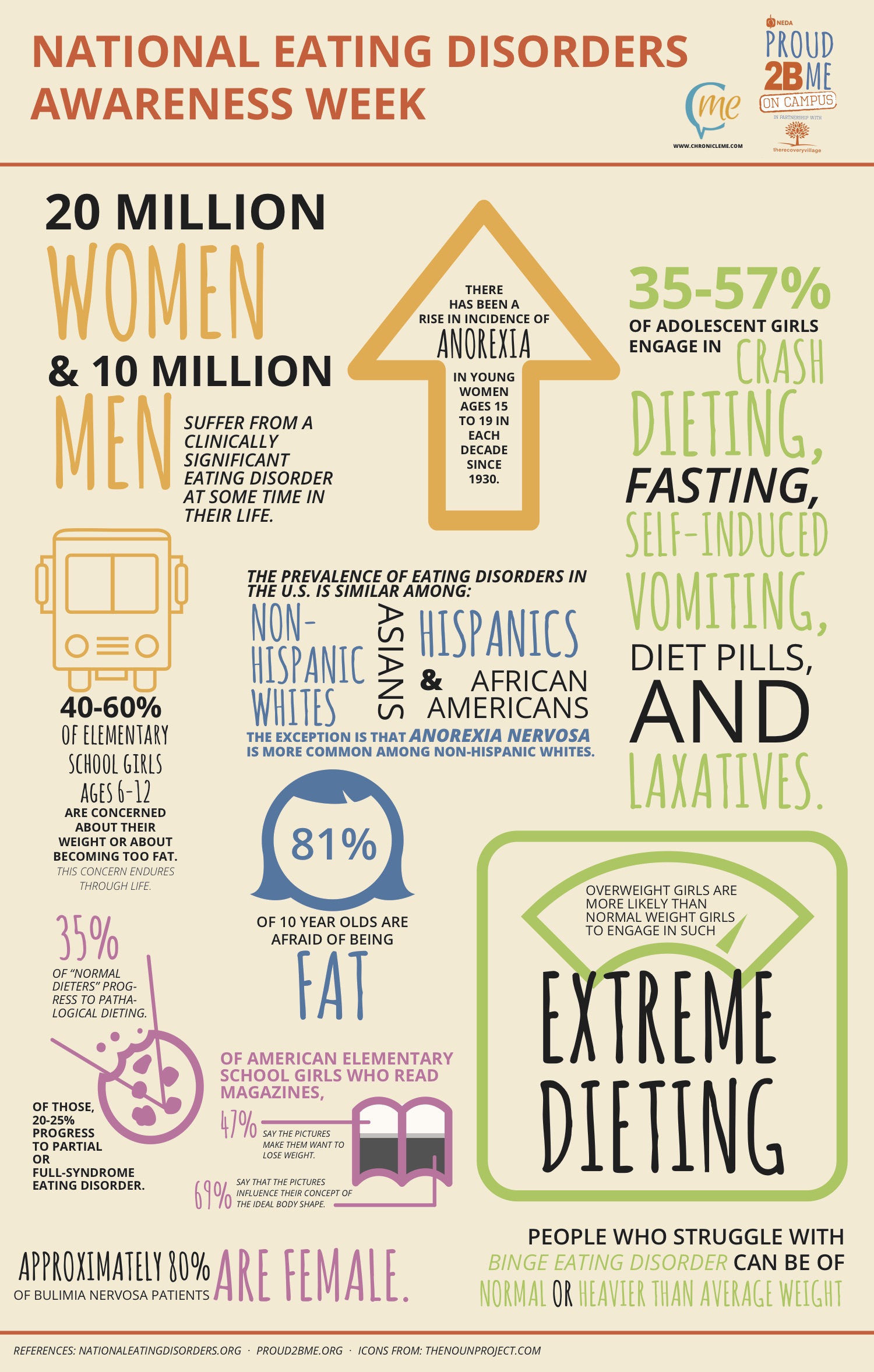This week is Eating Disorder Awareness Week 2015. To spread the word, Steps To Recovery, an organization that helps those battling issues of addiction and illness, wrote a guest post for Feminist Campus on the damaging effects of disordered eating on college-age women.
Irresponsible Images Driving Eating Disorders Among College Women
Close to 80 percent of women report dieting during their first year at college and around 10 percent of women suffer from an eating disorder during college. This makes female college students one of the groups at highest risk of developing anorexia nervosa, bulimia nervosa and binge eating disorder. Contrary to popular belief, high educational achievement and the ability to cope in demanding situations are not protective against disordered eating, and young women face a range of possible triggers for poor body image and an unhealthy relationship with food.
Eating Disorder Triggers
Certain psychological traits place young women at greater risk of disordered eating, which include those who seek perfection, those who are people-pleasers, those who are driven by the fear of failing, those who have difficulty expressing their emotions and those who suffer from poor self-esteem. The academic and social pressures of college may trigger an eating disorder among those women at particular risk, but even without a predisposition to eating problems, taking part in college sport is another risk factor, especially those disciplines that value leanness such as running and gymnastics.
Various factors relating to family also increase the likelihood of eating disorders. For instance, besides a family history of eating disorders, other mental health problems in the family, ranging from depression to substance misuse are a risk factor for women in college. Families that impose rigid rules and have high expectations, particularly where appearance is involved, can make disordered eating more likely, as can chaotic, abusive or overprotective family relationships. These factors then make it more difficult for students to resist the cultural pressure to be thin.
Cultural Triggers for Eating Disorders
Another misconception about eating disorders is that it largely affects white women from higher socioeconomic groups. However, there is growing evidence of disordered eating among women from various ethnic groups, with young women from diverse backgrounds dieting because they are dissatisfied with their weight, believe that they are overweight and have insecurities about their body image. Indeed, rates of dieting are similar among white, black, Hispanic and Asian students. Women from all cultures are exposed to images of the ideal figure from an early age, which may explain similarities in disordered eating behaviors across various backgrounds.
Despite her unrealistic figure, Barbie is still the most popular doll among girls, so before they even attend school many young females receive the message that they should be thin. Such a dangerous role model, with her tiny 18″ waist (compared to the average waist circumference of 37.5″ for American women), is believed to be behind the rising incidence of eating disorders among girls in elementary school. However, exposure to fashion dolls that can damage self-esteem and promote poor body image is just the start. As girls grow up they come into contact with all manner of potentially harmful images in the media.
The Media and Eating Disorders
Adolescents and young adults see multiple adverts on a daily basis that depict women who are not only slim, but often to the point where they are malnourished. These highly slender figures are usually accompanied by other desirable characteristics such as beauty, fashionable clothing and success, which encourages young impressionable women to pursue this body shape, leading them to believe this is the only way that they can achieve what they are after. While this is far from the case, the adverts in magazines and on TV are so compelling that some young women start to regard thinness as the only way that this they can meet their goals, so will make efforts to slim down at any cost.
The influence of movies and TV shows is little better. Even though students might be well aware that actresses that take a size 0 or size 2 are far from the norm, this doesn’t mean that they don’t still desire the same figure as movie stars. With a perfectly healthy size 8 or 10 figure, such a slender shape is still usually out of reach and the only way that young women can come close is through highly restrictive dietary practices and excessive exercise regimens. The majority of TV stars are more slender than average too, and with young adults typically watching three or four hours of TV each day, this drives women to go after the same body type that they see on their screens. Watching TV sitcoms is a particular concern, as overweight characters tends to be on the receiving end of jokes, which reinforces the message that unless you are thin this is undesirable.
The rise of social media is another driver of disordered eating among college women who have particularly high use of social networking sites. Research suggests that the negative impact of social sharing sites, such as Facebook, Tumblr and Instagram, is potentially as great as that from mass media. In just the same way that the media can airbrush images, as users generate their own content on social media sites it is possible for them to choose the best pictures of themselves and edit them accordingly. For women at college who are already vulnerable to disordered eating, seeing the near perfect images of their contacts can be enough to trigger unhealthy habits in pursuit of an unnecessarily thin figure. By raising awareness of the distorted images from all media channels and rejecting these it is possible to reduce the poor self-esteem associated with them, which so often contributes to eating disorders among young women.


